1. Practical Geometry
- Books Name
- CBSE Class 6 Mathematics Book
- Publication
- Param Publication
- Course
- CBSE Class 6
- Subject
- Mathmatics
Introduction
Different different geometrical shapes are made with the help of ruler or straight edge and compass.
In this chapter we shall learn to make these shapes. In making these shapes we need to use some tools. So, we shall begin with listing these tools, describing them and looking at how they are used.
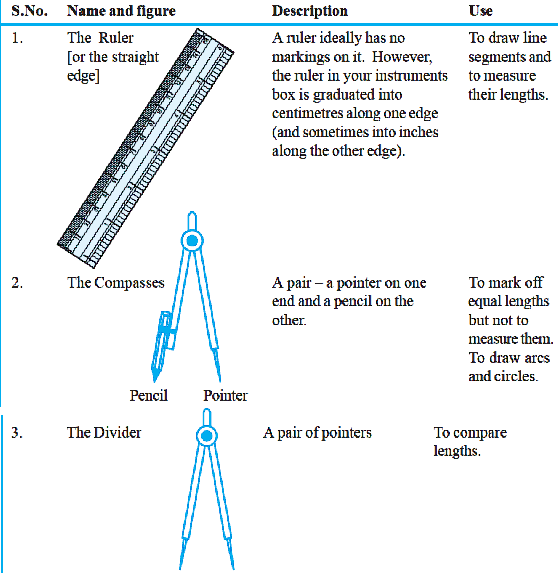
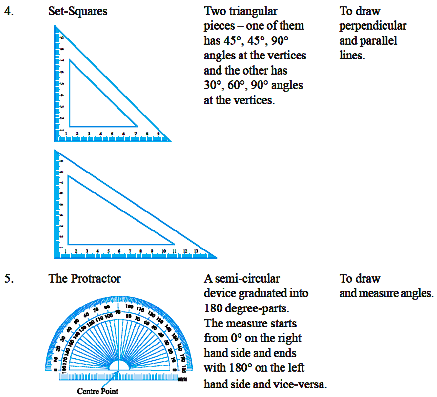
We are going to consider “Ruler and compasses constructions”, using ruler, only to draw lines, and compasses, only to draw arcs.
Construction of a circle when its radius is known
- Books Name
- CBSE Class 6 Mathematics Book
- Publication
- Param Publication
- Course
- CBSE Class 6
- Subject
- Mathmatics
Construction of a circle when its radius is known
Suppose we want to draw a circle of radius 3 cm. We need to use our compasses. Here are the steps to follow.
Step 1 Open the compasses for the required radius of 3 cm.
Step 2 Mark a point with a sharp pencil where we want the centre of the circle to be. Name it as O.
Step 3 Place the pointer of the compasses on O.
Step 4 Turn the compasses slowly to draw the circle. Be careful to complete the movement around in one instant.
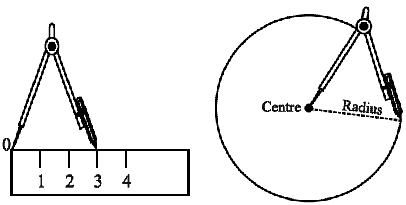
Line Segment
- Books Name
- CBSE Class 6 Mathematics Book
- Publication
- Param Publication
- Course
- CBSE Class 6
- Subject
- Mathmatics
Line Segment
A line segment is bounded by two end-points. This makes it possible to measure its length with a ruler.
If we know the length of a line segment, it becomes possible to represent it by a diagram.
Construction of a line segment of a given length
Suppose we want to draw a line segment of length 4.7 cm. We can use our ruler and mark two points A and B which are 4.7 cm apart. Join A and B and get AB . While marking the points A and B, we should look straight down at the measuring device. Otherwise we will get an incorrect value.
Step 1 Draw a line l. Mark a point A on a line l.

Step 2 Place the compasses pointer on the zero mark of the ruler. Open it to place the pencil point upto the 4.7cm mark.
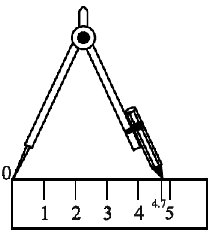
Step 3 Taking caution that the opening of the compasses has not changed, place the pointer on A and swing an arc to cut l at B.
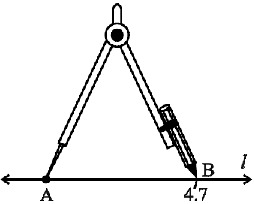
Step 4 AB is a line segment of required length.

Constructing a copy of a given line segment
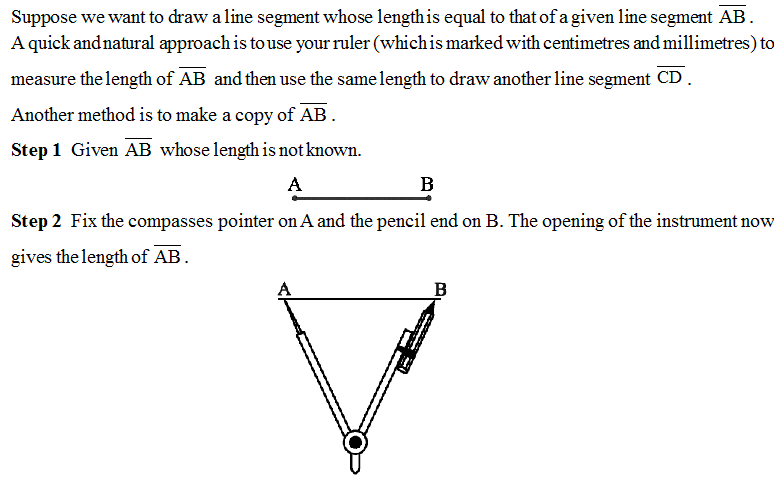
Step 3 Draw any line l. Choose a point C on l. Without changing the compasses setting, place the pointer on C.
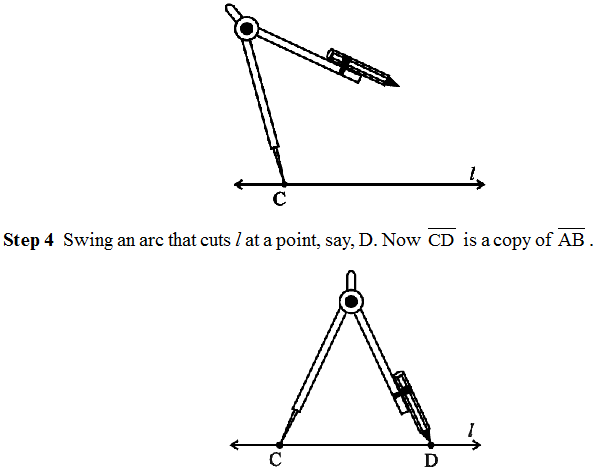
Perpendiculars
- Books Name
- CBSE Class 6 Mathematics Book
- Publication
- Param Publication
- Course
- CBSE Class 6
- Subject
- Mathmatics
Perpendiculars
We know that two lines (or rays or segments) are said to be perpendicular if they intersect such that the angles formed between them are right angles.
In the figure, the lines l and m are perpendicular.
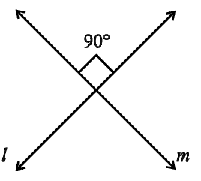
Perpendicular to a line through a point on it
Let us do an activity. Given a line l drawn on a paper sheet and a point P lying on the line. It is easy to have a perpendicular to l through P.
We can simply fold the paper such that the lines on both sides of the fold overlap each other.
Tracing paper or any transparent paper could be better for this activity. Let us take such a paper and draw any line l on it. Let us mark a point P anywhere on l.
Fold the sheet such that l is reflected on itself; adjust the fold so that the crease passes through the marked point P. Open out; the crease is perpendicular to l.
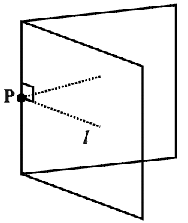
Construction perpendicular
Method-1 (Using Ruler and A Set-square)
Step 1 A line l and a point P are given. Note that P is on the line l.
![]()
Step 2 Place a ruler with one of its edges along l. Hold this firmly.

Step 3 Place a set-square with one of its edges along the already aligned edge of the ruler such that the right angled corner is in contact with the ruler.
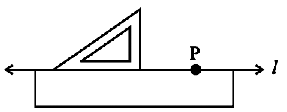
Step 4 Slide the set-square along the edge of ruler until its right angled corner coincides with P.
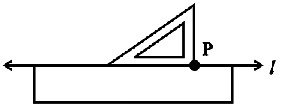
Step 5 Hold the set-square firmly in this position. Draw PQ along the edge of the set-square.
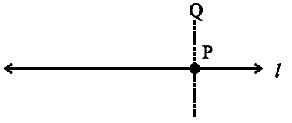
PQ is perpendicular to l.
Method-2 (Using to Ruler and Compasses)
Step 1 Given a point P on a line l.
![]()
Step 2 With P as centre and a convenient radius, construct an arc intersecting the line l at two points A and B.
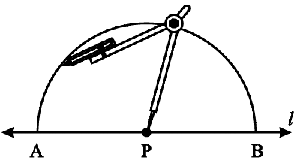
Step 3 With A and B as centres and a radius greater than AP construct two arcs, which cut each other at Q.
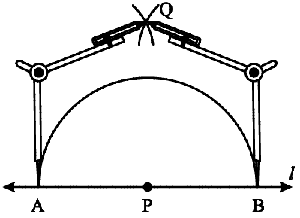
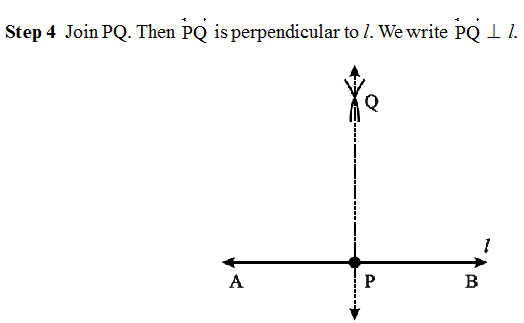
Construction Perpendicular to a line through a point not on it
Method-1 (Using Ruler and A Set-square)
Step 1 Let l be the given line and P be a point outside l.

Step 2 Place a set-square on l such that one arm of its right angle aligns along l.
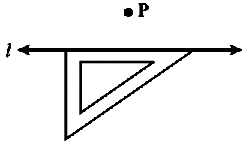
Step 3 Place a ruler along the edge opposite to the right angle of the set-square.
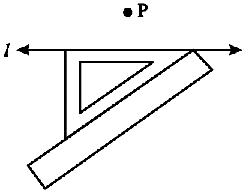
Step 4 Hold the ruler fixed. Slide the set-square along the ruler till the point P touches the other arm of the set-square.
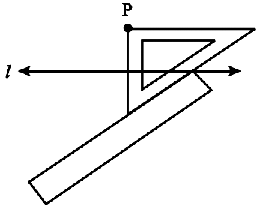
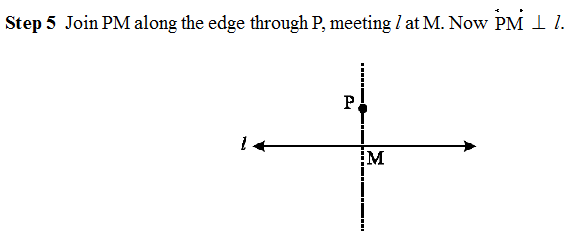
Method-2 (Using Ruler and Compasses)
This is the more convenient and accurate method.
Step 1 Given a line l and a point P not on it.
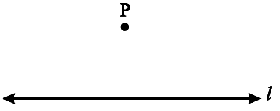
Step 2 With P as centre, draw an arc which intersects line l at two points A and B.
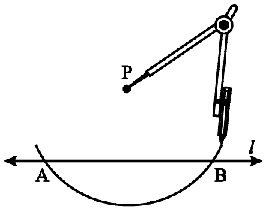
Step 3 Using the same radius and with A and B as centres, construct two arcs that intersect at a point, say Q, on the other side.
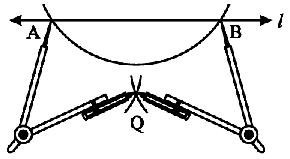
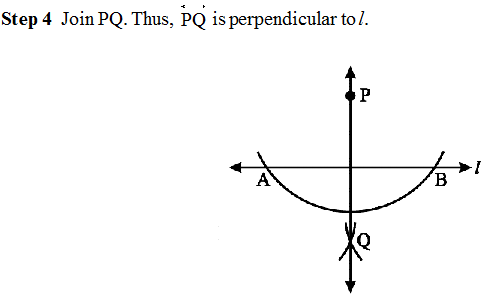
The perpendicular bisector of a line segment
- Books Name
- CBSE Class 6 Mathematics Book
- Publication
- Param Publication
- Course
- CBSE Class 6
- Subject
- Mathmatics
The perpendicular bisector of a line segment

Construction using ruler and compasses
Step 1 Draw a line segment AB of any length.
![]()
Step 2 With A as centre, using compasses, draw a circle. The radius of your circle should be more than half the length of AB.
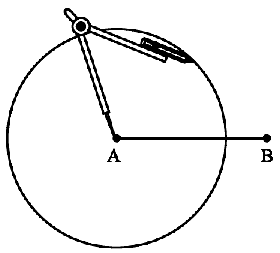
Step 3 With the same radius and with B as centre, draw another circle using compasses. Let it cut the previous circle at C and D.
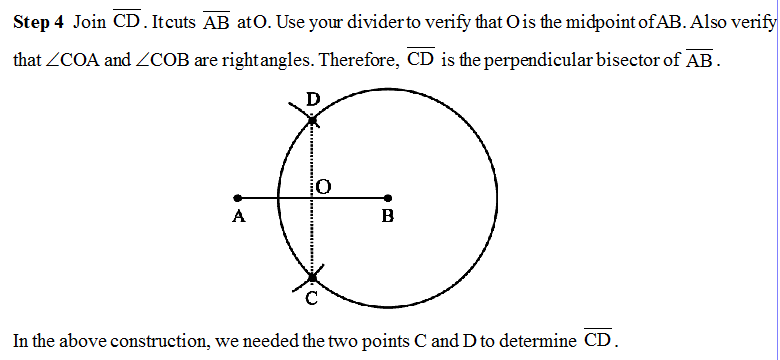
Angles
- Books Name
- CBSE Class 6 Mathematics Book
- Publication
- Param Publication
- Course
- CBSE Class 6
- Subject
- Mathmatics
Angles
Constructing an angle of a given measure
Suppose we want an angle of measure 40°.
Here are the steps to follow :
Step 1 Draw AB of any length.
![]()
Step 2 Place the centre of the protractor at A and the zero edge along AB.
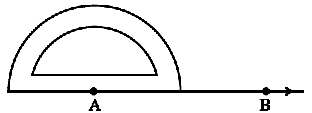
Step 3 Start with zero near B. Mark point C at 40°.
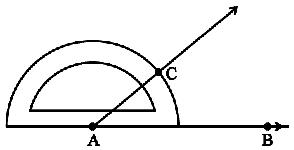
Step 4 Join AC. ∠BAC is the required angle.
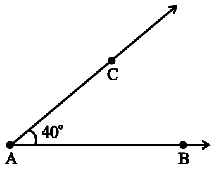
Bisector of an angle
Construction with ruler and compasses
Let an angle, say, ∠A be given.
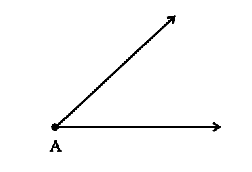
Step 1 With A as centre and using compasses, draw an arc that cuts both rays of ∠A . Label the points of intersection as B and C.
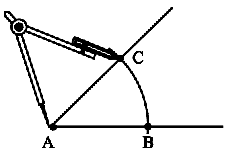
Step 2 With B as centre, draw (in the interior of ∠A ) an arc whose radius is more than half the length BC.
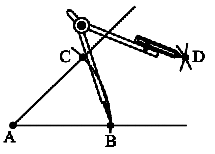
Step 3 With the same radius and with C as centre, draw another arc in the interior of ∠A. Let the two arcs intersect at D. Then AD is the required bisector of∠A .
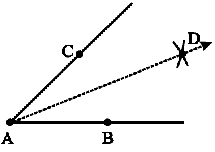
Construction of Special Angles
- Books Name
- CBSE Class 6 Mathematics Book
- Publication
- Param Publication
- Course
- CBSE Class 6
- Subject
- Mathmatics
Construction of Special Angles
Constructing a 60° angle
Step 1 Draw a line l and mark a point O on it.
![]()
Step 2 Place the pointer of the compasses at O and draw an arc of convenient radius which cuts the line PQ at a point say, A.
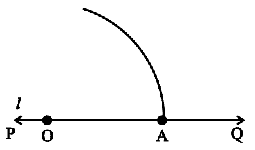
Step 3 With the pointer at A (as centre), now draw an arc that passes through O.
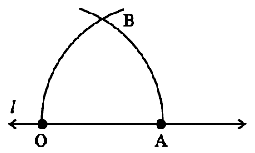
Step 4 Let the two arcs intersect at B. Join OB. We get ∠BOA whose measure is 60°.
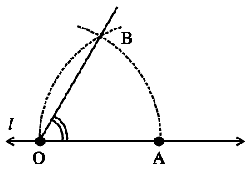
Constructing a 30° angle
Construct an angle of 60° as shown earlier. Now, bisect this angle. Each angle is 30°, verify by using a protractor.
Constructing a 120° angle
An angle of 120° is nothing but twice of an angle of 60°. Therefore, it can be constructed as follows :
Step 1 Draw any line PQ and take a point O on it.
![]()
Step 2 Place the pointer of the compasses at O and draw an arc of convenient radius which cuts the line at A.
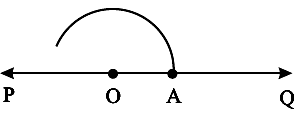
Step 3 Without disturbing the radius on the compasses, draw an arc with A as centre which cuts the first arc at B.
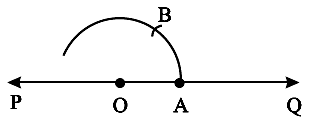
Step 4 Again without disturbing the radius on the compasses and with B as centre, draw an arc which cuts the first arc at C.
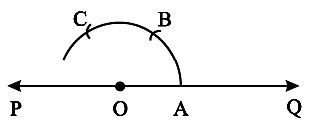
Step 5 Join OC, ∠COA is the required angle whose measure is 120°.
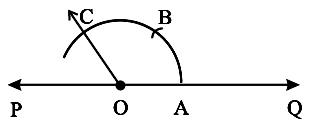
Constructing a 90° angle
Step 1 With A as centre and any suitable radius draw an arc cutting AB at P.
Step 2 With P as centre and the same radius as before cut the arc of Step 1 at Q. With Q as centre and the same radius cut the arc again at R.
Step 3 With Q and R as centres and any convenient radius (same for both) draw arcs cutting at S. Join A to S and produce A to L. Then ∠BAL = 90°, i.e., AL is perpendicular to AB at A.
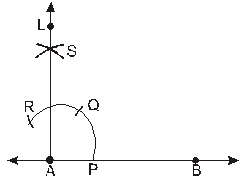

 ReginaTagebücher
ReginaTagebücher
 Param Publication
Param Publication
